Groningen 作者: 来源: 发布时间:2021-04-29
一、所属省或是州,具体位置,人口,面积
Groningen is the main municipality as well as the capital city of the eponymous province in the Netherlands. It is the largest city in the north of the Netherlands and has 231,037 inhabitants (31 January 2019) on a total area of 180.21 km2 (69.58 sq mi), and land area of 168.93 km2 (65.22 sq mi) with a population density of 1,367 per km2 (3,540 per square mile). It merged with Ten Boer and Haren municipalities in 1 January 2019. The Groningen-Assen metropolitan area has about half a million inhabitants. Groningen is a university city, with an estimated 32,700 students at the University of Groningen (1 October 2019), and an estimated 28,432 at the Hanze University of Applied Sciences (1 February 2020).
Province Groningen
City of Groningen
Total number inhabitants: approx 230 000
Percentage inhabitants with university degree: 44%
Average age inhabitants: 36 years old
Number of companies: 18 000 +
Number of jobs: 140 000 +
Government
• Body Municipal council
Area
• Municipality 83.75 km2 (32.34 sq mi)
• Land 78.05 km2 (30.14 sq mi)
• Water 5.70 km2 (2.20 sq mi)
Elevation 7 m (23 ft)
Population (31 March 2020)
• Municipality 232,735
• Density 2,963/km2 (7,670/sq mi)
• Urban 216,655
• Metro 360,748
Demonym(s) Groninger, Stadjer
Time zone UTC+1 (CET)
• Summer (DST) UTC+2 (CEST)
Postcode 9700–9747
Area code 050
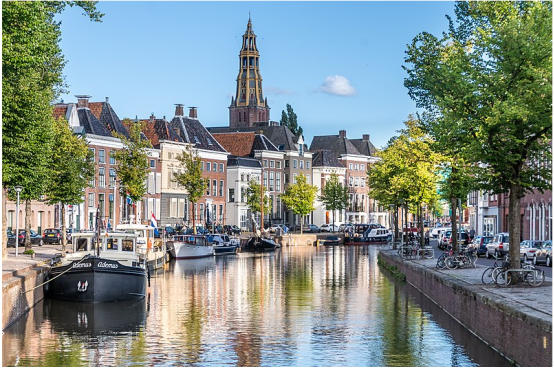
二、自然地理(地理环境、自然资源,交通情况)
Climate
Groningen has an oceanic temperate climate, like all of the Netherlands, although slightly colder in winter than other major cities in the Netherlands due to its northeasterly position. Weather is influenced by the North Sea to the north-west and its prevailing north-western winds and gales.
Summers are somewhat warm and humid. Temperatures of 30 °C (86 °F) or higher occur sporadically; the average daytime high is around 22 °C (72 °F). Very rainy periods are common, especially in spring and summer. Average annual precipitation is about 800 mm (31 in). Annual sunshine hours vary, but are usually below 1600 hours, giving much cloud cover similar to most of the Netherlands. Climate in this area has mild differences between highs and lows, and there is adequate rainfall year-round. The Köppen Climate Classification subtype for this climate is "Cfb". (Marine West Coast Climate/Oceanic climate).
Winters are cool: on average above freezing, although frosts are common during spells of easterly wind from Germany, Russia and even Siberia. Night-time temperatures of −10 °C (14 °F) or lower are not uncommon during cold winter periods. The lowest temperature ever recorded is −26.8 °C (−16.2 °F) on 16 February 1956. Snow often falls, but rarely stays long due to warmer daytime temperatures, although white snowy days happen every winter.
Population growth
The municipality of Groningen has grown rapidly. In 1968 it expanded by mergers with Hoogkerk and Noorddijk, and in 2019 it merged with Haren and Ten Boer. All historical data are for the original city limits, excluding Hoogkerk, Noorddijk, Haren and Ten Boer.
Transport
Cycling and walking
Groningen has been called the "World Cycling City" because 57% of journeys within the city are made by bicycle. Like most Dutch cities, Groningen is well adapted to the large number of cyclists. A large network of bike paths makes it convenient to cycle to various destinations. In 2000, Groningen was chosen as Fietsstad 2002 — top BikeCity of the Netherlands for 2002.
The city is very much adapted to the wishes of those who want to get around without a car, as it has an extensive network of segregated cycle-paths, good public transport, and a large pedestrianised zone in the city centre. The transformation of the historic centre into a pedestrian priority zone enables and invites walking and biking. This is achieved by applying the principle of "filtered permeability". It means that the network configuration favours active transportation and selectively "filters out" the car by reducing the number of streets that run through the centre. While certain streets are discontinuous for cars, they connect to a network of pedestrian and bike paths which permeate the entire centre. In addition, these paths go through public squares and open spaces, increasing the enjoyment of the trip (see image). The logic of filtering a mode of transport is fully expressed in a comprehensive model for laying out neighbourhoods and districts – the fused grid.
Public transport
Trains
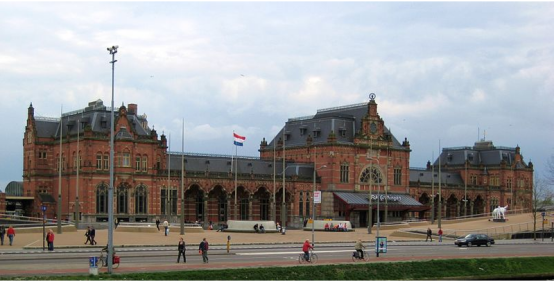
Railway station Groningen (2008)
The Station of Groningen or Hoofdstation as the locals call it, has regular services to most of the major cities in the Netherlands. The city's remaining two railway stations are Europapark and Noord.
On those six routes, ten lines stop at:
Groningen - Groningen North - Sauwerd - Bedum - Stedum - Loppersum - Appingedam - Delfzijl West - Delfzijl
Groningen - Groningen North - Sauwerd - Winsum - Baflo - Warffum - Usquert - Uithuizen - Uithuizermeeden - Roodeschool - (Low Service) Eemshaven
Groningen - Zuidhorn - Grijpskerk - Buitenpost - De Westereen - Feanwâlden - Hurdegaryp - Leeuwarden Camminghaburen - Leewarden
Groningen - Buitenpost - Leewarden
Groningen - Groningen Europapark - Kropswolde - Martenshoek - Hoogezand-Sappemeer - Sappemeer oost - Zuidbroek - Veendam
Groningen - Groningen Europapark - Kropswolde - Martenshoek - Hoogezand-Sappemeer - Sappemeer oost - Zuidbroek - Scheemda - Winschoten - (Lower service) Bad Nieuweschans - Weener - (Due to a broken bridge, the does noe go on to Leer. Take a bus form Groningen or Weener)
Groningen - Groningen Europapark - Haren - Assen - Beilen - Hoogeveen - Meppel - Zwolle
Groningen - Assen - Zwolle - Amersfoort Centraal - Utrecht Centraal - Gouda - Rotterdam Alexander - Rotterdam Centraal
Groningen - Assen - Zwolle - Lelystad Centrum - Almere Centrum - Amsterdam South - Schiphol - Leiden Centraal - Den Haag Centraal / The Hague Centraal
Buses
Groningen has many bus lines and Q-Link, a network of busses similar to a tram / metro network. The bus company Qbuzz has created a similar system, U-Link in Utrecht.
City & Q-Link Lines:
1: Main Station - City Center - UMCG North - Station Groningen North - Zernike - P+R Reitdiep
2: Groningen Europapark - UMCG Main Entrance - UMCG North - Station Groningen North - Zernike - Station Zuidhorn
3: Lewenborg - P+R Kardingen - Main Station - P+R Hoogkerk - Leek
4: Beijum - P+R Kardingen - Main Station - P+R Hoogkerk - Peize - Roden
5: Harkstede - P+R Meerstad - UMCG Main Entrance - City Centre - Main Station - P+R Haren - Zuidlaren - Annen
6: P+R Haren - Main Station - UMCG Main Entrance - Ten Boer - Appingedam - Delfzijl
7: De Wijert - Main Station - Westerhaven - Vinkhuizen - Paddepoel - Station Groningen North
8: P+R Hoogkerk - Hoogkerk - Westerhaven - Main Station -Groningen Europapark - Corpus den Hoorn - Martini hospital - P+R Hoogkerk
9: Eelde - Paterswolde - Martini hospital - Corpus den Hoorn - De Wijert - Main Station - Westerhaven - Paddepoel - Station Groningen North Or Zernike
10: Corpus den Hoorn - Martini hospital - Main Station - Korrewegwijk - Station Groningen North
12: Main Station - Groningen Europapark - Euvelgunne - Eemspoort - P+R Meerstad - P+R Kardingen
15: Main Station - Paddepoel - Zernike
18: P+R Hoogkerk - Vinkhuizen - Paddepoel - Zernike
Car
The A28 motorway connects the city of Groningen to Utrecht (via Assen, Zwolle and Amersfoort). The A7 motorway connects Groningen to Friesland and Zaandam (West) and Winschoten and Leer (East).
Airport
Groningen Airport Eelde is located 10 kilometres (6 miles) south of the centre of Groningen, with scheduled services to Guernsey, Gran Canaria, Antalya, Crete, Mallorca & Bodrum.
Ferry
A ferry service is being proposed between The Eemshaven and Rosyth, Scotland.
三、经济发展和规模
Until recently, there were two large sugar refineries within the city boundaries. The Suiker Unie plant was originally outside Groningen, but it was completely swallowed by the expansion of the city. After a campaign to close the factory, it was finally shut down in 2008/2009. Before closing down, its sugar production amounted to 250,000 tonnes of beet sugar, with 250 employees (2005 figures). The only remaining sugar factory is CSM Vierverlaten in Hoogkerk, which produces 235,000 tonnes of beet sugar, with 283 employees.
Well known companies from Groningen are publishing company Noordhoff Uitgevers, tobacco company Royal Theodorus Niemeyer, health insurance company Menzis, distillery Hooghoudt, and natural gas companies GasUnie and GasTerra. There is an increased focus on business services; specifically IT, life sciences, tourism, energy, and environment. In addition, the hotel and catering industry forms a significant part of the economy of Groningen.
四、产业特点/重点项目
The main sectors in the Groningen region are:
Agriculture and agribusiness
Health and life sciences (focus on healthy ageing)
Chemistry (focus on green chemistry and advanced materials)
Energy
Digital and tech
Energy
Groningen is taking a leading role in the transition to sustainable energy.
Energy has traditionally been a strong sector in Groningen, and now the transition to sustainable energy sources forms an absolutely central focus in the Groningen region. For the past sixty years, the region has been a major supplier of natural gas. Currently about one third of the electricity consumed in the Netherlands comes from Groningen, and a growing share of this has been generated sustainably. Recent programmes underline the region’s ambition to become Europe’s most sustainable industrial area by 2030. The city of Groningen was recently appointed as a European ‘lighthouse city’ for its leading role in the energy transition.
Energy activities centre around the Eemsdelta, and Campus Groningen at Zernike Science Park.
Energy port at Eemsdelta
The Eemsdelta region forms an important European connection port for sustainable energy sources such as the Gemini offshore wind farm and Norwegian hydroelectric power plants, as well as a location for more wind and sun farms, such as Sunport Delfzijl, the biggest solar energy park in the Netherlands. This solar park supplies the Google data centre at the Eemshaven with energy, making it the first 100% renewably powered centre for Google.
Energy hub at Zernike
The Campus Groningen location at Zernike Science Park is home to the New Energy Coalition, a merger between three organisations with an extensive track record in energy: Energy Valley, Energy Academy Europe and the Energy Delta Institute. Together with living labs such as EnTranCe and EnergySense these organisations represent the collective ambition to make Groningen a sustainable energy leader. The organisations are located in the most sustainable education building in Europe. The Global Centre on Adaptation is also located in this building.
Established parties see a major role for young talent in the transition to a sustainable energy supply. Graduates from one of the many energy programs can get started at the energy companies and startups with energy innovations are also enthusiastically received.
Bio-based economy
The European Union has designated the North Netherlands region as one of the six leading regions for the bio-based economy. The combination of strong agri-food, chemical and energy sectors enables Groningen to play a pioneering role in the transition to a bio-based economy.
With the launch of Chemport Europe in 2017, the Eemsdelta has cemented its status as the most sustainable chemical cluster in Europe. The presence of chemical industry, (sustainable) energy, biomass, knowledge and seaports give the Eemsdelta a unique starting position for developing sustainable chemistry.
At Chemport Europe, the northern chemical clusters work together with knowledge institutions such as the University of Groningen and Hanze University of Applied Sciences Groningen. Groningen is the green gas capital of the Netherlands due to the large production sites at Suikerunie and Attero. And Delfzijl also has the largest bio-energy plant in the Netherlands.
Advanced materials and nanotechnology
Chemistry in Groningen is the home of Ben Feringa, who won the Nobel Prize in Chemistry in 2016 for his research on a light-driven rotary molecular motor, as well as other top scientists such as Sibren Otto.
It is also the home of the world-renowned Zernike Institute of Advanced Materials, responsible for the Top Master Programme in Nanoscience. The chemistry masters has also been labelled a top programme. At the nearby Hanze University of Applied Sciences the Chemical Engineering programme was labelled best in the Netherlands in 2018.
These programmes feed into the entrepreneurship clusters at Campus Groningen and the Eemsdelta.
Digital Society
Groningen is the second tech city in the Netherlands for five years in a row now. Campus Groningen is the fastest growing start-up campus in the Netherlands and home to many tech companies. Founded in Groningen provides an overview of the local tech and digital ecosystem.
Recent developments in the Groningen digital sector worth highlighting include:
Annual Blockchain Hackathon (biggest worldwide)
First European 5G field lab launched in 2018
Cybersecurity programme launched in 2018 in triple-helix partnership
Digital Literacy Coalition launched in 2018
Urban Data Centre launched in 2017
Tech companies IBM and Google are located in the province, with Google recently expanding its data centre in the Eemshaven. In terms of infrastructure, the Eemshaven is considered a top European dataport.
Tech talent
The study programmes in artificial intelligence, information science and media studies at the University of Groningen have been judged ‘best in category’ in the most recent survey of higher education in the Netherlands. The Hanze University of Applied Sciences Groningen hosts the Digital Society Hub, where researchers and companies work together on digital innovation.
The presence of talent in the region has been explicitly named as part of the success for local companies such as HackerOne, Voys, Looking for Booking and Paylogic.
Agrifood
The province of Groningen has been an agricultural region for many centuries, with a focus on potato and sugar beet crops, seed potatoes and livestock. About 70% of the land in Groningen is still used for agriculture. 23% of global seed potato exports come from Groningen.
Also in this sector, the transition to a sustainable and circular economy is the main focus. Increasingly, the agricultural sector is working together with the chemical sector in the bio-based economy. Greenlincs is a network for agrifood and bio-based economy in the Northern Provinces. Recently the University of Groningen joined forces with the provincial government to launch a chair for sustainable agriculture.
Main players in the agricultural sector are:
Avebe, a cooperative of over 2500 farmers together forming the largest producer worldwide of potato starch products, and Koepen, world leader in the field of artificial insemination of meat and dairy cattle.
And again in this sector, a collaborative and pioneering attitude dominates, as is visible in the Avebe innovation centre, launched in 2018, and the Carbohydrate Competence Centre, the leading knowledge centre in the Netherlands in the field of carbohydrates.
Healthy Ageing
Groningen is a main cradle of knowledge in the area of Healthy Ageing and various research institutes such as the European Research Institute for the Biology of Ageing (ERIBA) and Lifelines attest to this. Recent developments include the launch of the the Aletta Jacobs School of Public Health, the building of the dedicated Healthy Ageing Campus next to the University Medical Centre Groningen, and the award of top Dutch honours and prize to Professor Ciska Wijmenga.
According to the latest EU innovation monitor, Groningen ranks as the third Dutch city in the biotech field (after Amsterdam and Leiden) due to the high number of companies, highly educated employees, and turnover of dedicated life sciences enterprises in the region.
As in other key sectors, collaboration between the knowledge institutes and the public and private sector characterises the Groningen approach to the health and life sciences field. Education, fundamental and clinical research programmes feed into entrepreneurial networks such as the Healthy Ageing Network Northern Netherlands (HANNN) and Health Hub Roden. Start-ups in the health sector are supported by Triade, a daughter organisation of the University Medical Centre Groningen for incubation and investment support for innovation in Health and Life Sciences.
Because of this clear focus and successful collaboration, the European Commission has marked North Netherlands as a leading region for Active and Healthy Ageing.
五、风景名胜,景点
Groningen is a city full of museums. There is a comics museum, a tobacco museum and a science museum. One of the largest is the Groningen Museum. This structure is a work of art in and of itself and is known as one of the most beautiful museums in all of the Netherlands.
The most famous museum in Groningen is the Groninger Museum. Its new building, designed by Alessandro Mendini, has transformed the museum into one of the most modern and innovative of its kind in the Netherlands. In addition, the city has a maritime museum, a university museum, a comics museum and a graphics museum. Groningen is also the home of Noorderlicht, an international photographic platform that runs a photo gallery and organizes an international photo festival.In 2019, the Forum Groningen opened. This cultural centrum consists of a museum, art cinema, library, bars, rooftop terrace and tourist information office.
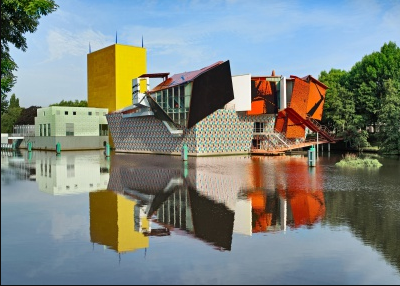
Groninger Museum (2006)
The Groninger Museum was founded in 1874 and opened its own building twenty years later on the Praediniussingel, in 1894. The Menkemaborg, a historic mansion, was donated to the Groninger Museum by the heirs of its last inhabitants in 1921. The current building of the museum was opened in 1994.
Groninger Museum: Museumeiland 1, 9711 ME Groningen, The Netherlands
Postal address: Postbus 90, 9700 ME Groningen, The Netherlands
info@groningermuseum.nl
Tel: +31 50 3 666 555
Website www.groningermuseum.nl
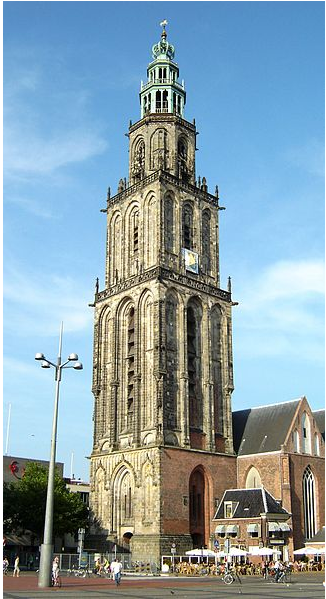
Martinitoren
Location Groningen, Netherlands
Geographic coordinates 53.21921°N 6.5680°ECoordinates: 53.21921°N 6.5680°E
Architecture
Type Church tower
Style Gothic
Groundbreaking 1469
Completed 1482
Height (max) 96.8 m (317.59 ft)
The Martinitoren is the highest church steeple in the city of Groningen, Netherlands and the bell tower of the Martinikerk.
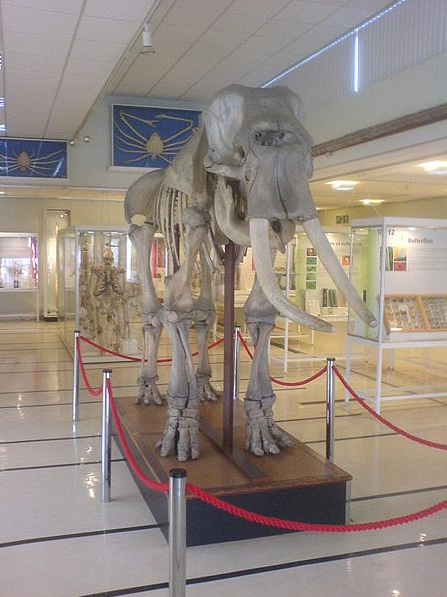
A mounted Elephant skeleton at the Cole Museum of Zoology, situated in the University of Reading's Whiteknights Campus.
A university museum is a repository of collections run by a university, typically founded to aid teaching and research within the institution of higher learning. The Ashmolean Museum at the University of Oxford in England is an early example, originally housed in the building that is now the Museum of the History of Science. A more recent example is the Holburne Museum of Art in Bath, originally constructed as a hotel in 1796 it is now the official museum of the University of Bath.
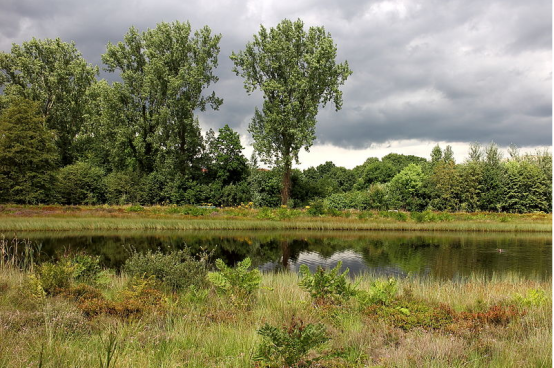
Lake in the Hortus Haren (Voedselarme plas).
Hortus Haren
Type Botanical garden
Location Haren
Coordinates 53°10′46″N 6°36′9″ECoordinates: 53°10′46″N 6°36′9″E
Area 21 hectares (210,000 m2)
Created 1626
Website http://www.hortusharen.nl
Hortus Haren is a botanical garden in Haren, Groningen, Netherlands. First created in 1626 by the pharmacist Henricus Munting, it was then situated between Grote Rozenstraat and Grote Kruisstraat in Groningen. Because of space considerations it relocated to Haren in 1967 and became the largest botanical garden in the country.
六、历史文化
The city was founded at the northernmost point of the Hondsrug area. The oldest document referring to Groningen's existence dates from 1040. However, the city already existed long before then: the oldest archaeological traces found are believed to stem from the years 3950–3720 BC, although the first major settlement in Groningen has been traced back to the 3rd century AD.
In the 13th century, when Groningen was an important trade centre, its inhabitants built a city wall to underline its authority. The city had a strong influence on the surrounding lands and made its Gronings dialect a common tongue. The most influential period of the city was the end of the 15th century, when the nearby province of Friesland was administered from Groningen. During these years, the Martinitoren, then 127 metres (417 feet) tall, was built; it loomed over the city. The city's independence ended in 1536, when it chose to accept Emperor Charles V, the Habsburg ruler of the other Netherlands, as its overlord.
In 1594, Groningen, until then held by Spain, was captured by a Dutch and English force led by Maurice of Nassau. Soon afterwards the city and the province joined the Republic of the Seven United Provinces.
In 1614, the University of Groningen was founded, initially only for religious education. In the same period the city expanded rapidly and a new city wall was built. That same city wall was tested during the Third Anglo-Dutch War in 1672, when the city was attacked fiercely by the bishop of Münster, Bernhard von Galen. The city walls resisted, an event that is still celebrated with music and fireworks on 28 August (as "Gronings Ontzet" or "Bommen Berend").
The city did not escape the devastation of World War II. In particular, the main square, the Grote Markt, was largely destroyed in April 1945 in the Battle of Groningen. However, the Martinitoren, its church, the Goudkantoor, and the city hall were not damaged. The battle lasted several days.
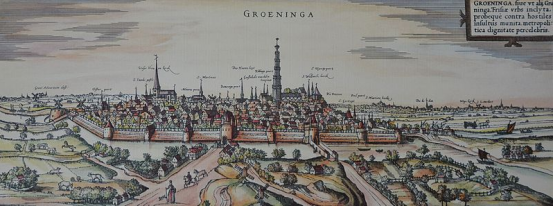
Groningen in the 16th century
Theatre and music
Groningen has a city theatre (Stadsschouwburg), located on the Turfsingel; a big theatre and concert venue called Martini Plaza; and another major cultural venue on the Trompsingel, called the Oosterpoort. Vera is located on the Oosterstraat, the Grand Theatre on the Grote Markt, and Simplon on the Boterdiep. Several cafés feature live music, a few of which specialize in jazz music, including Jazzcafe De Spieghel on the Peperstraat. The jazz music students from the Prince Claus Conservatoire have been known to hold regular jam sessions in cafés such as Peter Pan on the Voor Het Voormalige Klein Poortje and café De Smederij on the Tuinstraat 2–4. Groningen is also the host city for Eurosonic Noorderslag, an annual music showcase event for over a hundred bands from all over Europe.
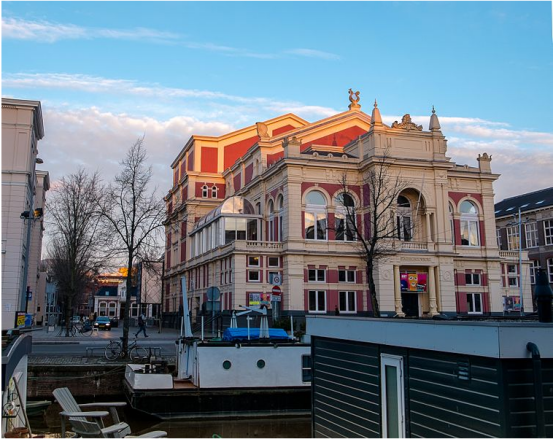
Theatre building Groningen
Nightlife
Groningen's nightlife depends largely on its student population. Its cultural scene is vibrant and remarkable for a city its size. In particular, the Grote Markt, the Vismarkt, the Poelestraat and Peperstraat are crowded every night of the week, and most bars do not close until 5 in the morning. Between 2005 and 2007, Groningen was elected "best city centre" of the Netherlands. Groningen has a red-light district, called Nieuwstad. A second one in the A-kwartier (an area) has been closed as of late 2015. Both areas are in or near the city centre.
Sports
The local football club is FC Groningen, founded in 1971. As at the 2018–19 season they play in the Dutch top football league, the Eredivisie. Winners of the KNVB cup in 2014/15, their best league result was in the Eredivisie in the 1990–91 season, when they finished third. Their current stadium, which opened in January 2006, is the Hitachi Capital Mobility Stadion (before the 2015–2016 season it was called the Euroborg stadium and it was called Noordlease Stadion from 2016 to 2018) which has 22,550 seats.
American sports are fairly popular in Groningen; it has American football, baseball, and basketball clubs. Groningen's professional basketball club, Donar, play in the highest professional league, the Dutch Basketball League, and have won the national championship seven times. The Groningen Giants are the American Football Team of Groningen. They play in the Dutch Eredivisie and are considered the "Kings of the North".
One of the biggest running events of the country, the 4 Miles of Groningen, takes place in Groningen every year on the second Sunday in October.
The 2002 Giro d'Italia started in Groningen, including the prologue and the start of the 1st stage. The city also hosted the start and finish of the 5th stage of the 2013 Energiewacht Tour.
The University of Groningen was founded in 1614 primarily for religious studies.The city remains a center for art and culture in the Netherlands and is a popular tourist attraction. The city bears the distinction of being one of the youngest cities in the Netherlands, with the average age of its population being between 20 and 24 years of age.
The city is often referred to as the Metropolis of the North, and plays an important role in the fields of art, music, business and education. In fact, it is estimated that one out of every five people in Groningen in a student.
七、其他信息
Groningen is an old city (more than 950 years) and was the regional power of the north of the Netherlands, a semi-independent city-state and member of the German Hanseatic League.
The city is nationally known as the "Metropolis of the North" and as "Martinistad" referring to the tower of the Martinitoren, named after its patron saint Martin of Tours.
Although Groningen is not a very large city, it does have an important role as the main urban centre of this part of the country, particularly in the fields of music and other arts, education, and business. The large number of students living in Groningen also contributes to a diverse cultural scene for a city of its size.
Since 2016 Groningen is host of the International Cycling Film Festival, an annual film festival for bicycle related films. It takes place in the art house cinema of the old Roman Catholic Hospital.
Due to its impact and emphasis on education, Groningen is also a City of Talent, and in 2009 it was awarded as a Fair-trade town. The people who live in Groningen are generally happy and in fact were voted most satisfied with their city in a recent poll of more the 75 European cities.
八、联系方式
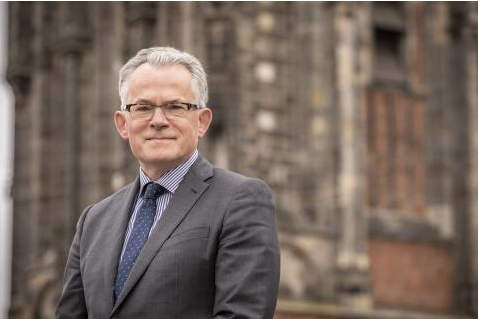
Mayor Koen Schuiling (VVD)
Born: February 1, 1959, Rotterdam, Netherlands
Education: University of Groningen (1978–1984)
Office: Mayor of Groningen since 2019
Government
• Body Municipal council
Postcode 9700–9747
Area code 050
Phone: 050 367 7000
From abroad: +31 50 367 7000
WhatsApp: 06 1282 3973
From abroad: +31 6 1282 3973
Postal address: Gemeente Groningen, Postbus 30026, 9700 RM Groningen
Website groningen.nl/en/
Twitter: Gemeente Groningen
@gem_groningen
Facebook:
Gemeente Groningen
@groningen050
